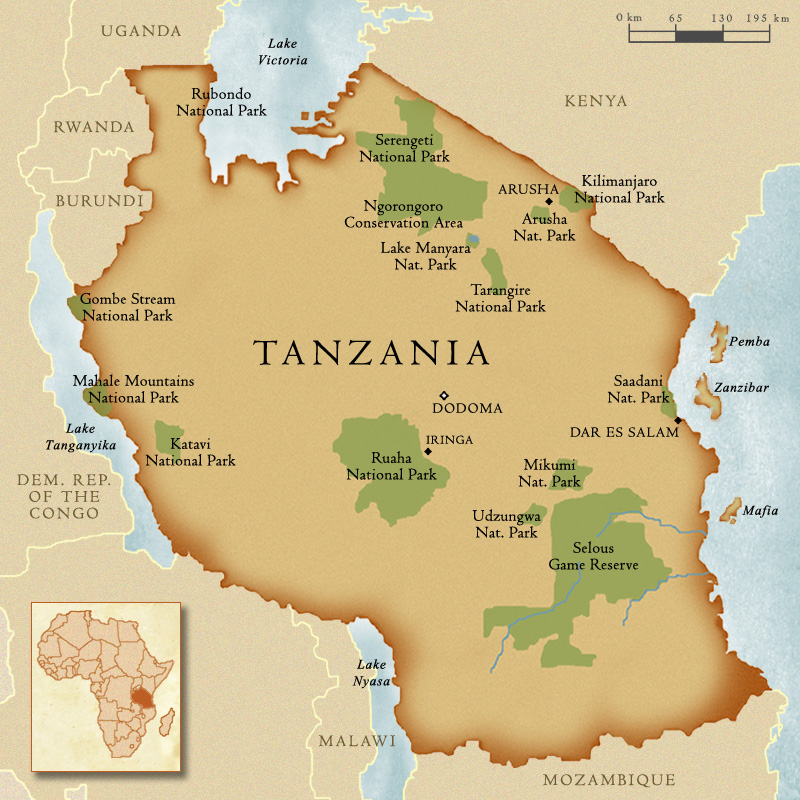Tanzania Quick Facts
 Size: 364,020 square miles
Size: 364,020 square miles
Population: 42,746,620
Capital: Dodoma
Climate: Equatorial
Economy: Agriculture, Manufacturing, Mining
Language: Swahili, English
Currency: Tanzanian shillling
Timezone: EST +8
Visa: Yes
Best Time to Visit: January February March June July August September October November December
Tanzania is a superb wildlife country, and has the greatest percentage of land, per capita, in national parks than any other African country. Tanzania is also one of the very few places on the continent that is actually ADDING acreage to the National Park system.
Tanzania is, however, far more season than is Kenya, so when you come will determine, to some extent, whether or not you want to spend much time Tanzania. But at the right time of the year Tanzania is absolutely unbeatable. Let me explain…
- The almost mythical Serengeti is every bit as good as you could possibly imagine. Getting to this park was my childhood dream, my goal. I’ve been there a million times now and come every January, February and March there is no where else in the world I would prefer to be than losing myself in the vastness of the Serengeti Plains.
This park is made up of huge woodlands, high hills, deep valleys and rivers, and, over and above all, the plains of the central and south. With its surrounding wildlife areas of Maswa, Loliondo, Ikoma, and Macao, the Serengeti covers and area of almost 14,000 square miles; making it larger than the state of Connecticut.
The wildebeest are the seasonal driving force here, though the non-migrating lions, leopards, cheetahs, hyenas, giraffe, elephant and buffalo certainly are major players on this stage.
The stage is full beyond all belief during the first four months of each year, for this is when the wildebeest congregate in astronomical numbers on the southeastern plains. They are here to calve out; and there will be some 300,000 calves born, all in one three week period, 96% of them born between 8:00am and 10:00am. I know this, and so do all the predators. This is why I am here every year at this time.
- Ngorongoro Crater: This crater is a World Heritage site, and is the largest intact caldera in the world. It is over 2,000 feet deep, has a perfectly flat grassland floor that covers more than 110 square miles, and supports the highest density of both lions and hyenas on the face of the earth.
The Crater Lodge, which sits right on the rim looking down into the depths, is a stunning place from which to base while exploring the concentrated wildlife of Ngorongoro Crater.
- Tarangire, Selous, Ruaha, Katavi Plains; Farther afield lie a number of lesser well known parks, such as Katavi, Selous and Ruaha. Their very remoteness, alone, makes then worthwhile destinations of untouched beauty.
Game in these more “wilderness” parks is generally shyer than in the more heavily traveled places, but you are virtually guaranteed to have the entire wilderness to yourself because folks just can’t get to these lovely destinations. But since we have our own plane these parks are readily accessible to just us.
- Zanzibar Island: The sheer sound of the name “Zanzibar” brings up romantic images of history and splendor. Today, however, most of Zanzibar is very heavily developed and quite often crowded. The eastern and north eastern sides of the island are still beautiful and relatively untouched. The scuba diving here is phenomenal, and Zanzibar town, the fish market and Stone Town are worth some time. But I don’t think Zanzibar compares in any way to either Lamu or Pemba Islands.
- Pemba Island. Pemba, north of Zanzibar, has remained truly rural and unaffected by the massive influx of tourism that has swept over Zanzibar. The island is still farm country, lovely coves, small and stunning getaway spots, great diving and wonderful sailing as well. It is Pemba, not Zanzibar, that was and still is “the spice island”. Even today there are over 3 million clove trees here.
- MOUNT KILIMANJARO CLIMB - We offer fully guided climbs on all routes ranging from 5 to 8 night treks. Our guides and porters are known as some of the best all around in the industry and having personally climbed the mountain with these guys i can say for myself they are the BEST. All of our climb itineraries are customized based on the client as everyone has different interests and levels of fitness. Our Goal is make sure every client has the best possible opportunity to summit. To learn more please inquire.


